Four pathways to decarbonisation
With the release of the latest UN Intergovernmental Panel on Climate Change (IPCC) report, debate about how quickly Australia should decarbonise and a federal commitment to net zero emissions by 2050 has been re-ignited.
Separately the CSIRO, in conjunction with ClimateWorks Australia, has undertaken an assessment of decarbonisation scenarios, including net zero 2050, to model the changes in emission trajectories for various sectors. The modelling considers the scale of energy efficiency and electrification and other fuel switching that could be associated with decarbonisation of the economy, as well as its implications for demand in the National Electricity Market (NEM).
This work forms part of the scenario planning undertaken for the Australian Energy Market Operator’s 2022 Integrated System Plan. Part of the CSIRO led Multi-sector energy modelling seeks to quantify the changing influences that would affect electricity demand under various emissions targets between 2019-20 and 2050-51.
The four scenarios[i] it considered are:
- Net zero 2050 – this is based on existing government policies
- Step Change – government policy and corporate goals leads to change beyond current policy.
- Hydrogen Superpower – high levels of electrification and hydrogen production with strong decarbonisation targets
- Strong electrification – expanded role for electrification in economy but smaller role for hydrogen, but with ambitious decarbonisation
A table showing the key drivers in each scenario is at the bottom of this article.
Overall, the modelling finds that Australia could meet net zero emissions on or before 2050. Below we take a close look at some of the findings.
Four pillars
Achieving net zero emissions across the economy relies on four pillars of decarbonisation:
- Energy efficiency to improve energy productivity and reduce energy waste.
- Decarbonising electricity to zero or near-zero emissions
- Electrification and a shift away from fossil fuels to zero- or near-zero emissions alternatives
- Non-energy emissions reductions and offsetting of residual emissions.
Across all its scenarios, increased energy efficiency, near 100 per cent renewables by 2050 and increased electrification all play a role while abatement of non-energy emissions is also needed across all scenarios through carbon sequestration.
Energy efficiency
The report considers that energy efficiency is one area that could be accelerated in the shift to low emissions even ahead of the grid decarbonising. Its potential uptake under each scenario is shown in figure 1.
Figure 1: Energy Efficiency in NEM
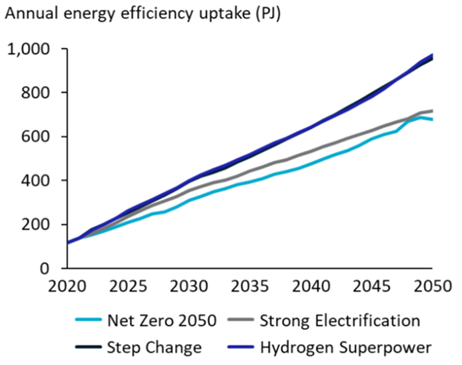
Note: Uptake shown as PJ energy avoid per year, across all fuel types in end-use sectors. Source: Multi-sector energy modelling
Demand Growth
Underlying NEM demand is expected to grow in all scenarios. Under the net zero 2050 and step change scenarios electricity demand would increase by 133 per cent and 108 per cent by 2050 respectively – demand would reach 446TWh (net zero) and 398TWh (step change). While there would be increased energy efficiency expected in the step change scenario, growth in demand remains significant because of increase electrification. Electrification would include areas like heating and water services in buildings, process heating in industrial and agricultural sectors, the shift to electric vehicles and short-haul non-road transport.
Under the hydrogen superpower scenario demand would increase by 116 per cent before new industries, such as green steel and hydrogen exports, emerged. With those new industries demand growth would be 468 per cent higher, equivalent to 1063TWh, which is more than five times the current NEM’s electricity demand.
The strong electrification scenario would result in growth in NEM demand of 143 per cent by 2050, or 464TWh.
Figure 2: Electrification and change in NEM demand
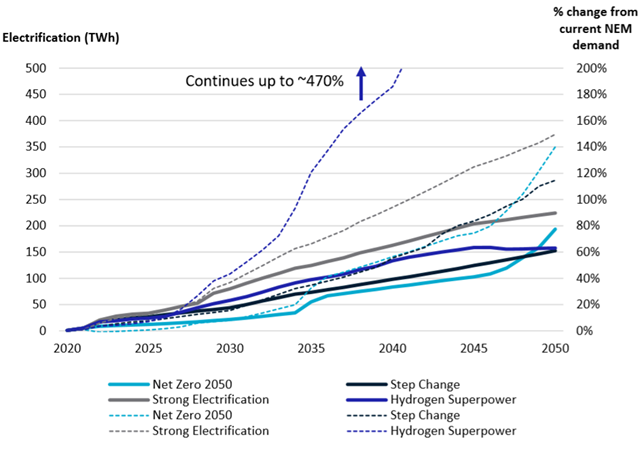
Source: Multi-sector energy modelling
The graphs in figure 3 show which sectors would be expected to drive demand under each scenario.
Figure 3: Electricity demand By sector
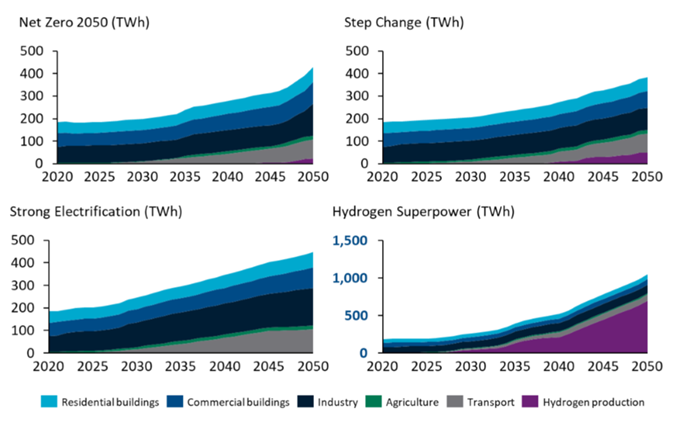
Source: Multi-sector energy modelling
Generation
Unsurprisingly the modelling expects the deployment of renewables to accelerate. Falling technology costs for renewable generation as well as storage, along with the ageing of coal-fired generators and the cost competitiveness of electrification with strong emissions reduction targets are the key factors behind an increasing share for renewable generation, mainly through utility-scale solar and wind farms over the projected period.
Under the net zero 2050 scenario moderate growth in demand along with state-based renewable energy targets see increased renewable generation, along with an increasing need for dispatchable storage for system stability (pumped hydro and batteries).
The other scenarios would lead to a more rapid drop in coal-fired generation – it would be phased out earliest (2035) in the strong electrification and hydrogen superpower scenarios. While some coal generation remains in the grid in the step change scenario until the late 2040s, its output is minimal and the report notes it may be forced out earlier due to the minimum operating levels (this pattern is also seen in the net zero 2050 scenario).
The change in the generation fleet forecast by the modelling is show below.
Figure 4: NEM generation mix by scenario
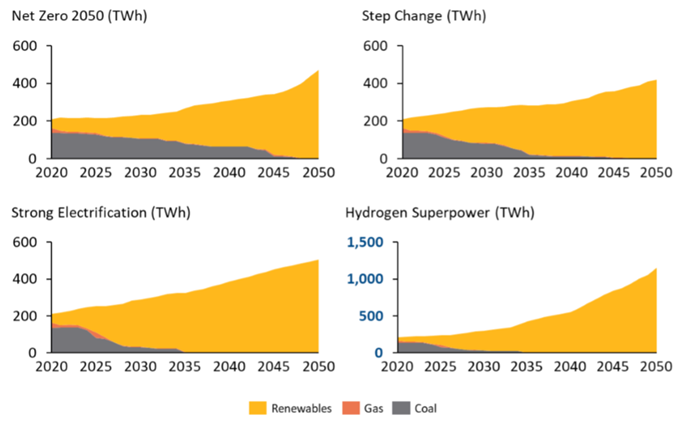
Source: Multi-sector energy modelling
As a result of the shift in generation, there would also be a strong reduction in emissions from the electricity sector (see 5 below).
Figure 5: Emissions reduction in NEM
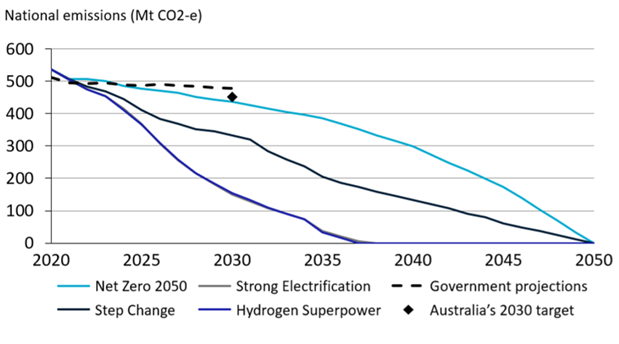
Source: Multi-sector energy modelling
Abatement
The scenario planning looks at the need for non-energy emissions from agriculture, land and hard-to-abate industrial processes to be tackled through abatement options such as sequestration.
“While it is assumed that the role for sequestering emissions is reserved for only the hardest-to-abate emissions in the economy, every scenario modelled… features some level of carbon sequestration, largely from land-based methods but with a small component from CCS ranging from between 4-14 per cent.”
Sequestration through carbon capture and storage (CCS) and land-based (which is modelling as carbon forestry) were considered. The CCS is not included for generation because it is not considered to be cost competitive. Small levels of CCS are assumed for industry.
Under the net zero 2050 and step change scenarios around 140MT CO2-e/year is sequestered by 2050. The other two scenarios have significantly higher levels of carbon forestry earlier reaching 136MT CO2-e/year (strong electrification) and 169MT CO2-e/year (hydrogen superpower) in 2037.
The amount of emissions sequestered under each scenario is shown below.
Figure 6: Total emissions sequestered by scenario
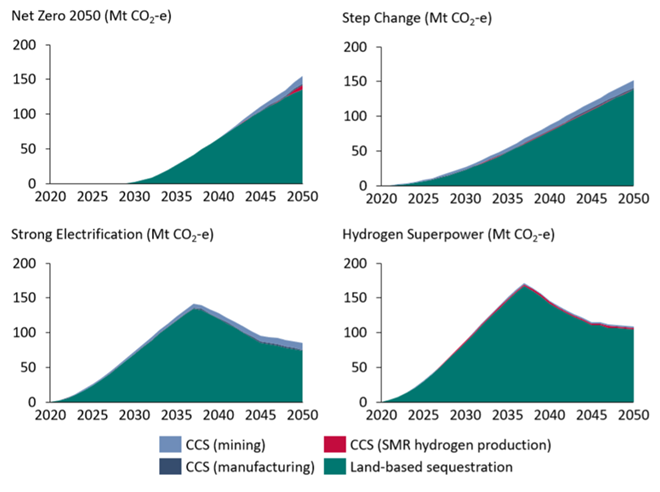
Source: Multi-sector energy modelling
Table 1: Drivers for each scenario
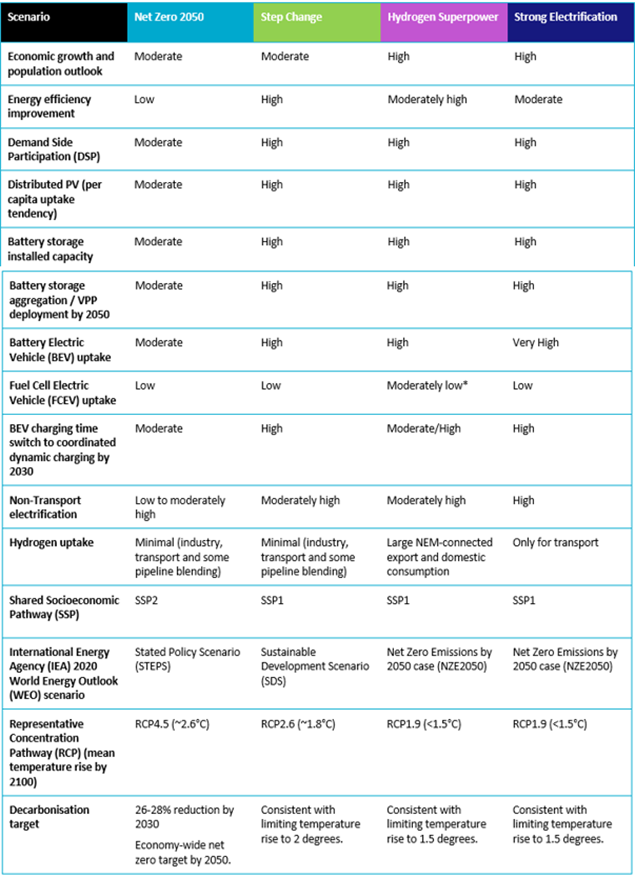
Source: Multi-sector energy modelling
[i] A detailed outline of each scenario and key factors from the report can be found in section 2.1 Scenario Overview, Multi-sector energy modelling
Related Analysis
Climate and energy: What do the next three years hold?
With Labor being returned to Government for a second term, this time with an increased majority, the next three years will represent a litmus test for how Australia is tracking to meet its signature 2030 targets of 43 per cent emissions reduction and 82 per cent renewable generation, and not to mention, the looming 2035 target. With significant obstacles laying ahead, the Government will need to hit the ground running. We take a look at some of the key projections and checkpoints throughout the next term.
Certificate schemes – good for governments, but what about customers?
Retailer certificate schemes have been growing in popularity in recent years as a policy mechanism to help deliver the energy transition. The report puts forward some recommendations on how to improve the efficiency of these schemes. It also includes a deeper dive into the Victorian Energy Upgrades program and South Australian Retailer Energy Productivity Scheme.
2025 Election: A tale of two campaigns
The election has been called and the campaigning has started in earnest. With both major parties proposing a markedly different path to deliver the energy transition and to reach net zero, we take a look at what sits beneath the big headlines and analyse how the current Labor Government is tracking towards its targets, and how a potential future Coalition Government might deliver on their commitments.
Send an email with your question or comment, and include your name and a short message and we'll get back to you shortly.



